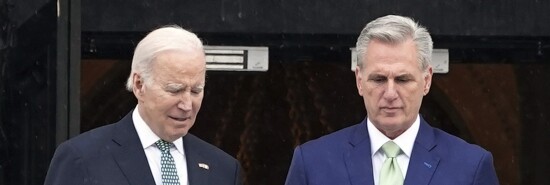
Fed’s favored inflation measure jumps (again), pressuring Biden to pass GOP debt ceiling bill
Tiana Lowe Doescher
Video Embed
As voters finally begin to blame inflation on Joe Biden‘s profligate spending, the president is staring down a potentially ruinous default on our $32 trillion national debt. While Biden has rebuffed the modest debt ceiling increase passed by House Republicans, one more point has been placed in House Speaker Kevin McCarthy’s (R-CA) camp.
Personal consumption expenditures inflation soared in April, increasing by 0.4% from March and 4.4% over the past year. These numbers, well past expert estimations, were up from March’s increases of 0.1% and 4.2%, respectively.
FOOD STAMPS: WHY SNAP BENEFITS COULD BE AMONG FIRST CASUALTIES OF DEBT CEILING CRISIS
Core PCE inflation, the Fed’s preferred inflation measure, also surpassed expectations, with a 0.4% increase over the month and a 4.7% increase over the year. Both measures, once again, were greater than the March prints.
Under Biden, inflation has gotten bad and stayed bad, so some would argue that April’s abysmal numbers won’t change the debt limit debate much. But markets would beg to differ. So long as fiscal policy continues to so aggressively stoke inflation, the Fed might have to enact even more onerous monetary policy to quash inflation — at the cost of $1 trillion in credit card debt being financed at higher and higher rates and mortgage rates topping 7%.
Just one month ago, Treasury bonds futures markets had priced in a 92% chance of at least 50 basis points in total cuts to the federal funds rate, with more than a third of a chance of at least one cut as early as the Fed’s July meeting of its Open Market Committee. Upon the release of April’s PCE numbers, markets priced in a majority likelihood of a hike come June, with a quarter chance of a second hike by July. And at long last, markets have come to accept the Fed’s promise of no cuts in 2023, with just a 42% shot of at least one cut by the December meeting.
CLICK HERE TO READ MORE FROM THE WASHINGTON EXAMINER
Unlike the debt ceiling battle of 2011, where voters polled roundly absolved Barack Obama of the blame, a plurality of voters blame Biden for a potential default, not McCarthy or the Republicans. Three in 5 voters support raising the debt limit only if combined with spending cuts, and 15% don’t support raising it at all. The conclusion to draw is clear: Voters are finally chaining the cause of Biden’s spending to the effect of inflation, and as evidenced by April’s PCE print, the problem is getting worse, not better.
The McCarthy bill is hardly radical. Rather than tack $19 trillion on the national debt over the next decade, as a “clean” debt ceiling increase would, the GOP bill would add a mere $14 trillion. Both policies are inflationary, the latter just less ruinously so. At this point, Biden should accept the McCarthy bill as a salvation from his own party, which doesn’t yet understand that whether it’s higher rates or higher inflation, the public is beginning to blame Democrats for the consequences.
